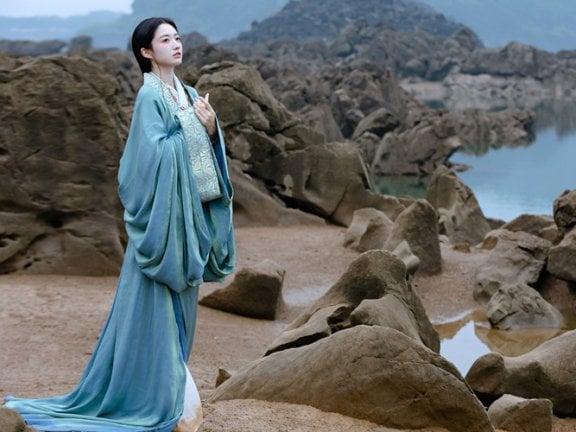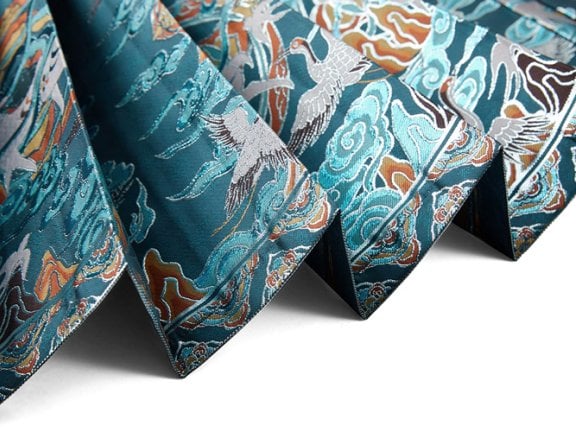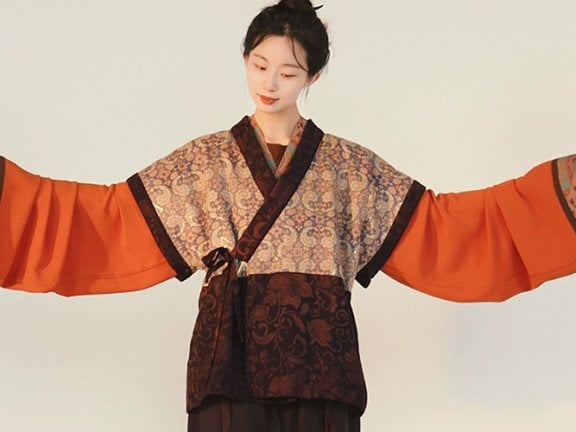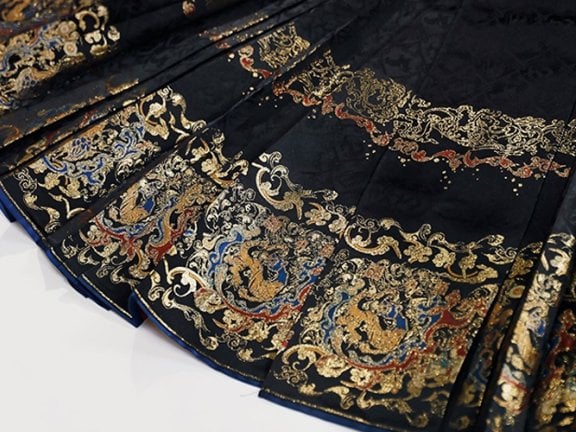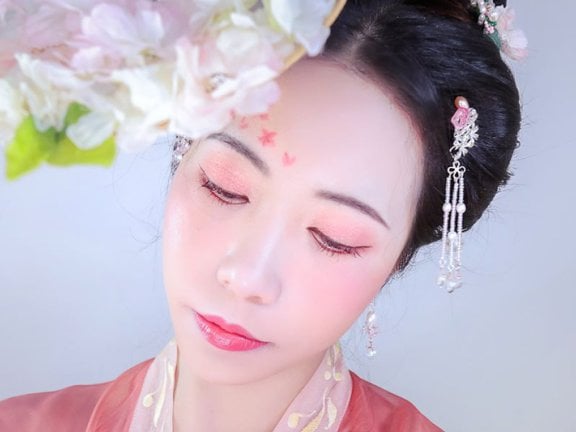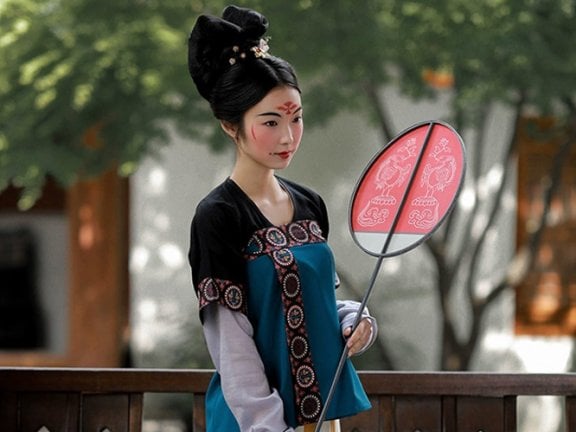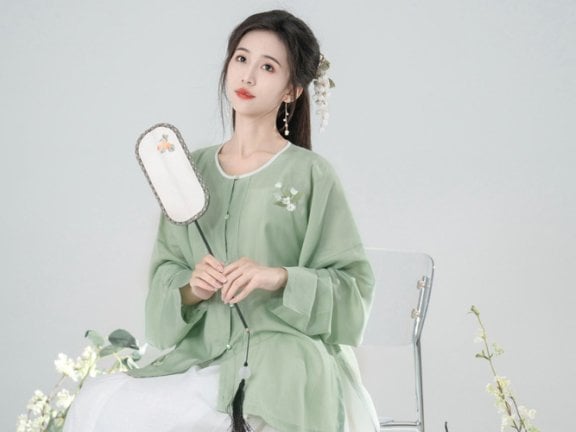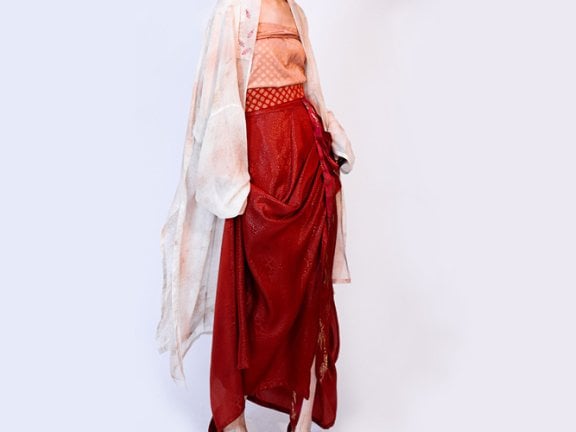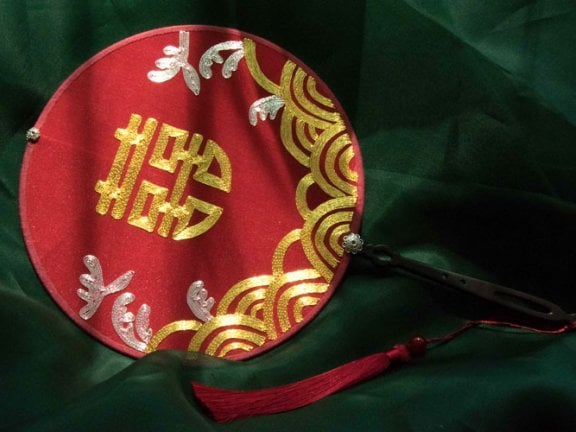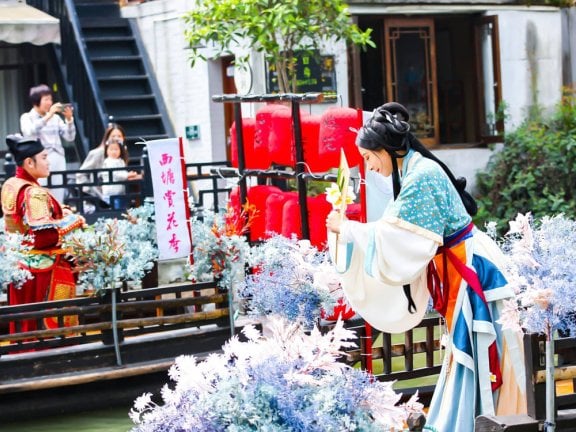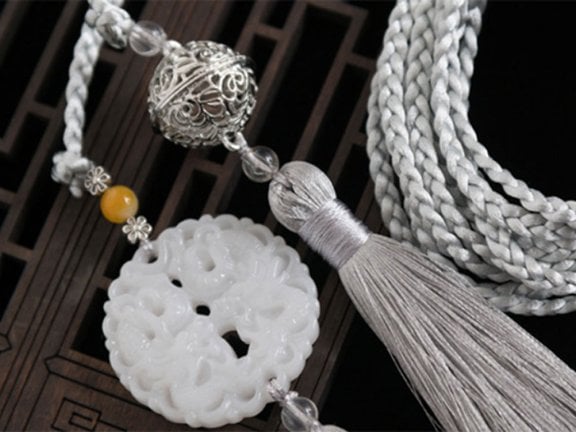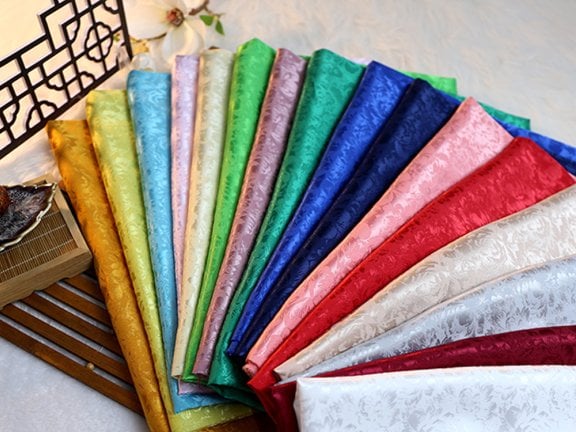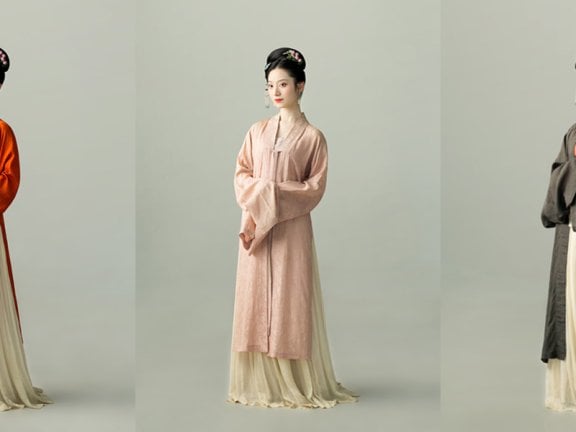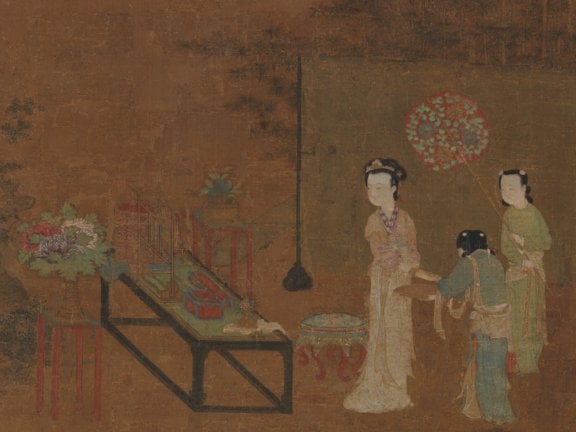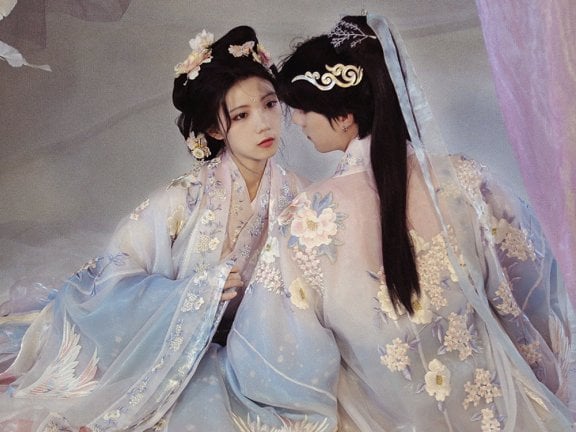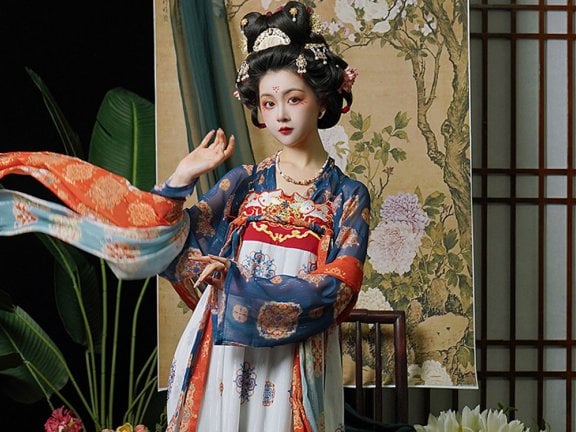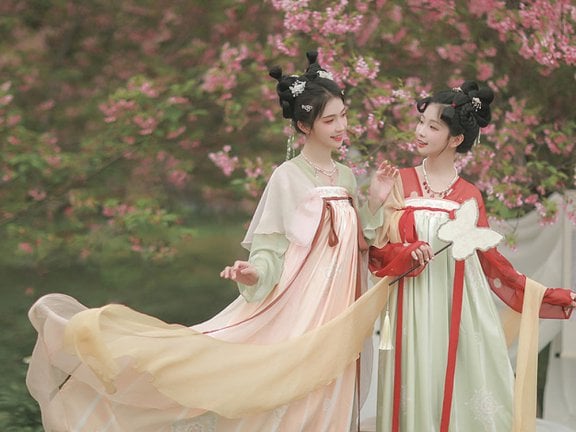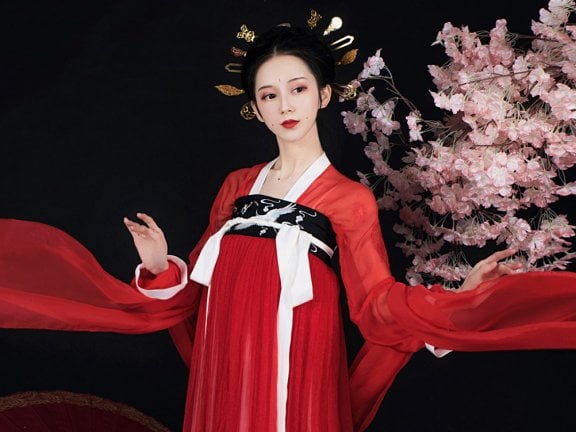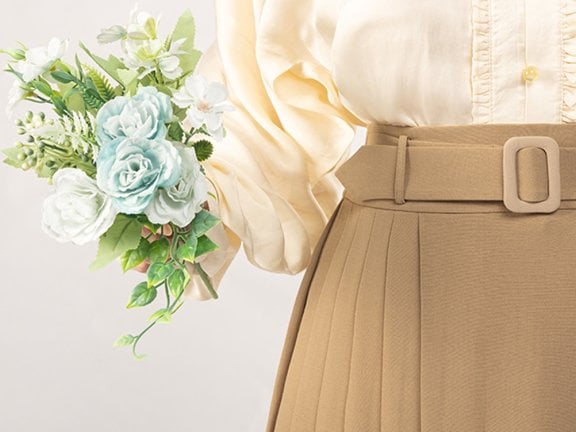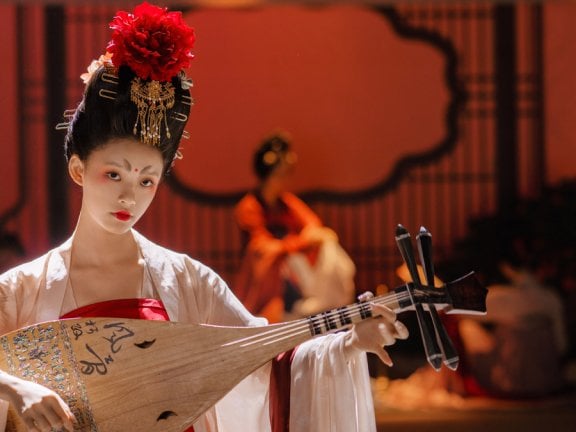-
Love Me, Love My Voice: Exploring the Modern Hanfu Fashion Style of the Female Protagonist
Recently, the new cdrama "Love Me, Love My Voice" starring Zhou Ye has been gaining popularity. Directed by Sha Weiqi, the drama features Tan Jianci and Zhou Ye as the lead actors, with Hou Wenyuan, Yang Zizi, Cao Enqi, and Chen Haolan in supporting roles. It premiered on November 30, 2023. Gu Sheng (played by Zhou Ye), a talented composer and university student, continues to strive for success in her music career. Her biggest wish is to collaborate with the renowned voice actor Mo Qingcheng (played by Tan Jianci). Unexpectedly, a chance encounter brings them together when Mo Qingcheng recites a recipe to her, stirring Gu Sheng's heartstrings. Ten years ago, Mo Qingcheng co-founded the Wanmei Dubbing Club with his friends, dedicating himself passionately to voice acting. He is also a cardiac surgeon, devoted to saving lives. Gu Sheng is invited to participate in a promotional event for her best friend Geng Xiaoxing's (played by Yang Zizi) company, which coincides with the tenth anniversary celebration of the Perfect Dubbing Club, bringing her closer to Mo Qingcheng once again. As Gu Sheng gradually gains fame, she faces doubts about her talent, but she remains true to herself, focusing on her work…- 0
- 0
- 27
-
Unveiling the Traditional Hanfu Warring States Robe
In the rich tapestry of Chinese history, traditional clothing is not just a matter of fabric and fashion; it's a vivid reflection of cultural values, social hierarchy, and artistic expression. Among these historical garments, the Hanfu Warring States Robe stands out as a symbol of elegance and a repository of stories from a time when China was divided yet culturally vibrant. This article delves into the mesmerizing world of the Hanfu Warring States Robe, a garment that encapsulates the essence of an era marked by turmoil, sophistication, and enduring legacies. In this journey through time, we will explore the origins and evolution of the Warring States Robe, its significance in the broader context of Hanfu and Chinese history, and how this ancient garment continues to influence modern fashion and cultural identity. Join us as we trace the golden threads of history, discovering the timeless elegance and profound symbolism embodied in the Warring States Robe. What is Warring States robe? The Warring States robe, literally speaking, refers to the robes and garments from the late Eastern Zhou Dynasty and the Warring States period. The main reference for the current Warring States robe on the market is the cultural relics from…- 0
- 0
- 44
-
Finding the Perfect Hanfu Mamian Qun: A Guide to Choosing the Right Style for You
Recently, the popularity of Mamian Qun (horse face skirt) shows no sign of waning. On November 23rd, at the opening night of VOGUE Forces of Fashion, Tong Yao's appearance in a Mamian Qun caught the attention of netizens. Mamian Qun are gradually integrating into our vision and lives. In light of this trend, I believe many people are eagerly longing to own a horse-face skirt, so let us follow the Hanfu Shidai explore the details to consider when selecting and styling a horse face skirt. I. Selection Stage Step 1: Size First and foremost, a suitable size that fits and contours to the body curves is crucial for a perfect outfit. Similar to a suit, one can choose to follow the size chart or opt for made-to-measure when selecting a Mamian Qun. Whether based on the size chart or personalized tailoring, the primary measurements to consider are height, waist circumference, and hip circumference. These factors will influence the choice of skirt length, waist length, and hem circumference. If we choose to purchase online, merchants often provide a size chart for customers to make their selection. By referring to the table, one can choose accordingly based on their own size…- 1
- 0
- 51
-
Get the Perfect Winter Hanfu Look with These Mixing and Matching Tips
One of the most challenging seasons for dressing is undoubtedly autumn and winter. When facing cold weather, how can we cleverly match Hanfu or Han-style fashion, both beautiful and practical, without sacrificing warmth? In the ancient Chinese civilization, the ancients had already designed and paid attention to the colors, wearing methods, fabrics, and other aspects of winter clothing, forming a systematic traditional dress culture. Today, we can draw inspiration from the wisdom of our ancestors and skillfully apply it to modern winter Hanfu, adding a touch of classical elegance to the overall outfit. The most important secret about the color and wearing methods of ancient Chinese winter clothing is layering and matching from the inside out. If we take the five colors as the main palette, we generally follow the principle of darker on the outside and lighter on the inside or vice versa. Dark colors such as pomegranate red, deep purple, dark green, jet black, and yellowish brown are suitable for outerwear, while lighter colors such as rosy red, sky blue, emerald green, charcoal gray, and apricot yellow are suitable for the inner layers. If you want a more distinctive look, you can also choose more vibrant colors for…- 0
- 0
- 58
-
How to Seamlessly Integrate the Mamian Skirt into Your Daily Outfits
Among the numerous garments of Hanfu, the most popular one is probably the Mamian skirt. As a clothing item full of ethnic style, the skirt is characterized by vibrant colors and unique patterns. Wearing it seems like traveling through time and experiencing the charm of traditional culture. In fact, the Mamian skirt is not a completely new design, its history can be traced back to a hundred years ago. Also known as Mamian pleated skirt, it was one of the main skirt styles for ancient Chinese women. It consists of four skirt doors, both front and back, overlapping in pairs. The outer skirt door is adorned with decorations, while the inner skirt door has fewer or no decorations. The Ma Mian Qun is pleated on the side, and the skirt waist is often made of white fabric, symbolizing a lifelong union. It is fastened with a rope or button. The design of the Mamian skirt highlights symmetry and streamlined shapes, emphasizing the curves of women and creating an elegant and dignified image for the wearer. The charm of the Mamian skirt has actually transcended national borders. At the banquet where Princess Diana was announced as the future royal bride in…- 0
- 0
- 120
-
Chinese Beauty Secrets and Ancient Skincare Methods
Without a doubt, China has some of the most convenient and effective skincare culture and products in the beauty industry. Just like AKT’s eco-friendly deodorant collection, traditional Chinese beauty products are made from ingredients straight from the bosoms of Mother Nature. Because China is rich in culture, many of their skincare practices date back to centuries ago and the routines we adopt can be traced back to them. Their beauty rituals have been passed down through generations like an heirloom. So, if you want to have flawless glass-like skin like the Chinese, we’ll let you in on some of their beauty secrets. 1. Jade Rollers and Gua Sha Stone for Face Sculpting Face sculpting is one of China’s oldest beauty practices. Jade rollers and Gua Sha stones were used to target acupuncture points and allow for better blood circulation. But it goes way deeper than that. In China, having a v-shaped or egg-shaped chin is the beauty standard. So, people use jade rollers and the gua sha stone as face sculpting tools that also help with lymphatic drainage. To them, a less puffy face is more attractive than full lips and doe eyes. Today, these face-sculpting tools are used all… -
A Dance with Dragons - Hanfu in Fantasy Festival
Hello hanfu lovers! Remember last year where I went to a fantasy festival dressed in Han dynasty hanfu? Of course you don't, here is the article. I did it again this year. With another hanfu from another dynasty. So every year there is this huge festival in the North of France on the 3rd weekend of September, named "Cidre et Dragon" (cider and dragon). It's in a little town on the beach, it attracts tens of thousands of visitors, merchants, and fantasy authors... and has the highest rate of costumed visitors that I know of. I've been going for 12 years now, but only recently began going in Hanfu. This is how we went last year: This year I chose a Ming dynasty style costume I made. I added a Yunjian I bought, because I just can't afford the time to do the embroideries. I also wore a wig because i cut my hair shorter this year. And here I am: You might be wondering what was that thing lying at my feet. Well, yeah, that's a dragon. What the internet calls a "fitness dragon". I saw it by chance on a online shop and googled a few videos of…- 2
- 3
- 82
-
Tang Dynasty Hairdos Examples: Discovering the Fascinating of Hanfu Hairstyles
During the Tang Dynasty, which was the pinnacle of feudal society in China, many aspects reached unprecedented heights. Well-known achievements such as poetry, calligraphy, painting, and dance were accompanied by a vibrant clothing culture that became one of the most dazzling chapters in Chinese fashion history. Consequently, hairstyles also exhibited an unimaginable array of colors and postures. High Bun The term "high bun" may refer to a specific type of bun hairstyle, but it is more likely a general term for tall buns. High buns were frequently seen during the Tang Dynasty and underwent continuous innovation in style. Many poets mentioned them in their works. The popularity of these high buns spanned the entire three hundred years of the Tang Dynasty. Lofty Bun Lofty Bun (峨髻, e ji) implies grandeur and magnificence. It is widely believed that the hairstyle depicted in Zhou Fang's painting "Court Ladies Adorning Their Hair with Flowers" represents lofty bun due to its towering mountain-like appearance. However, some people associate it with flower-decorated bun because women in the painting wear golden and silver floral accessories. Side Bun This type of bun existed as early as the Sui Dynasty. It involved creating a tall…- 1
- 0
- 329
-
Hanfu Accessory: Wrapped Flower History and Chan Hua Basic DIY Steps
Vocab of Wrapped Flower Wrapped flower - 缠花 (chán huā) - a name used to called artificially made flower using the techniques of wrapping colored silk thread around cut-out pieces and combining each parts together to make flowers, animals, insects, etc. Spring Flower - 春仔花 (chūn zǐ huā) or 春花 (chūn huā). Used in this situation would mean various types of flower combined into a small batch each flower symbolize for different meanings in China. In this case, the flower would be a wrapped flower rather than a real flower. History of Wrapped Flower Through ancient China, people held a profound appreciation for nature, which manifested in their beliefs of deities who governed natural forces to their interest in making poetry, music, and artworks that represented the beauty they saw. One remarkable custom in ancient China were the flower hair-pinning practice known as "簪花的习俗 (zān huā de xí sú)," where both men and women adorned their hair or hat with flowers, either fresh or artificially made. Talking about flowers, there are many artificial flower craftsmen that have passed down for centuries, including "ronghua" and "wrapped flower." The art of wrapped flowers originated during the Ming Dynasty and arrived in the…- 4
- 2
- 457
-
Discovering 8 Hanfu Color Styles: Timeless Elegance in Traditional Dress
Nowadays, hanfu is attracting more and more attention from enthusiasts due to its traditional charm. When choosing hanfu, enthusiasts no longer solely focus on the form, but also pay attention to style and color. This change in purchasing mindset has prompted hanfu designers to actively innovate and strive to provide a variety of styles. Today, let's explore the charm of different color schemes in hanfu. Red Color Hanfu In traditional symbolism, red not only represents auspiciousness and completeness but also signifies wealth and grandeur. If we want to create a luxurious style or participate in formal hanfu events, we can choose a hanfu with a deep red as the base color, paired with pink for transitions or adorned with gold thread embroidery. This combination showcases an elegant style while maintaining intricate craftsmanship. Furthermore, when paired with golden hairpins and waist ornaments, it exudes dignity and beauty. Blue Color Hanfu If we seek a fresh and casual dressing style, why not try the blue color scheme hanfu? Blue reminds us of clear skies and oceans; it is synonymous with freshness. Wearing blue-toned hanfu instantly transforms one into sprightly elves. For example, hanfu incorporates pink bows into the waist belt…- 0
- 0
- 179
-
Embrace the Grace of Summer Hanfu Fabrics: The Perfect Blend of Tradition and Comfort
From the enchanting landscapes of ancient China to the modern fashion runways, the timeless elegance of Hanfu garments continues to captivate hearts across the globe. As we embrace the warmth of summer, it's time to dive into the fascinating world of fabrics that effortlessly blend tradition with comfort, bringing forth a refreshing sartorial experience. Still bothered by what fabric is cooler for hanfu? This article will introduce you some common fabrics for summer hanfu. 01 Preliminary introduction to modern clothing fabrics Modern clothing materials can generally be categorized into three types: natural fibers, artificial fibers, and synthetic fibers. Artificial and synthetic fibers can also be combined to form chemical fiber. Natural fiber mainly refers to animal or plant-based fibers such as cotton, linen, wool and silk. Cotton has excellent moisture absorption properties while being breathable and warm but is prone to wrinkling; linen fiber doesn't curl easily but wrinkles easily with a rougher texture. Artificial fiber (also known as regenerated fiber) is made from natural polymers. According to the shape and usage of artificial fibers, they are divided into three categories: rayon, viscose staple fiber, and artificial wool. Important varieties include viscose fibre, acetate fibre, cuprammonium rayon fibre etc.…- 1
- 2
- 132
-
Wear Red Hanfu Dress to Brighten Up Your Summer
Summer is here, and what better way to celebrate the season than by brightening up your wardrobe with a stunning pomegranate red Hanfu dress. HAN TIME will use the combination of pomegranate color and hanfu as the starting point to recommend a series of suggestions for wearing red hanfu dress in summer. Pomegranate color refers to a slightly deeper shade of red, resembling the color of pomegranate fruit or bright orange-red like the color of pomegranate flowers. As summer approaches and greenery abounds, the blooming of pomegranate flowers marks the season's arrival. It is an ideal time to wear a flowing long skirt in a vibrant shade of pomegranate while standing under these blossoms with a radiant smile. When it comes to pomegranate skirts, people tend to lean towards the latter meaning as this hue is more charming and unique compared to other shades such as vermilion and pink. Have you ever heard of "kneeling under the pomegranate skirt"? The phrase has been passed down through generations related to Yang Guifei who had an affinity for both Pomegranates and dresses in that same rich hue. Emperor Xuanzong ordered widespread planting of Pomegranates within palace just for her love for them.…- 1
- 1
- 143
-
Hanfu Accessory: Tuanshan History and Shapes
Vocabulary Moon-shaped fan; 团扇 (tuánshàn). Also called 宫扇(gōng shàn), 纨扇 (wánshàn), 合欢扇 (héhuān shàn), a fan that is made from silks, embroideries, golds, beads, etc. later on into the period. Barrier fan; 障扇 (zhàng shàn) - one of the earliest version of fan from ancestors. Made with pheasant’s feathers and has a long handle. Also known as 长扇 (Chǎng shàn)、掌扇 (zhǎng shàn)、五明扇 (wǔ míng shàn). It is under the category of moon-shaped fan (团扇). Imperial carriage; 辇 (niǎn). Also known as chariot. This is the earlier versions of traveling vehicles primarily used by prestigious people for ceremonial processes, imperial tours, and any other formal occasions. The usage of this is closely related to imperial court instead of public, such as for emperor, queen’s mother, empress, and imperial concubines. These types of carriage are still man-drawn, and are made of simple designs with either a cushion or a chair for the individual seating on it. History of Tuanshan The moon-shaped fan, also known as 团扇 (tuánshàn), is a traditional handicraft tool of the Han people from ancient China. It consists of four main components: the fan's frame, handles (usually short in length), the fan's surface (made of semi-transparent or opaque…- 1
- 0
- 402
-
The Popularity of Hanfu Culture: When Traditional Hanfu Dress Comes to Contemporary Life
An increasing number of young people are beginning to experiment with wearing hanfu, these clothing styles, which were widely used in different historical dynasties in ancient China, are now being reintegrated into contemporary life and have become an important part of youth culture. The Origin of Hanfu Culture: From Niche to Popular Typically, the origin of the modern Hanfu culture is traced back to 2003. On November 22nd of that year, a power worker named Wang Letian from Zhengzhou, Henan, walked into a downtown commercial street wearing hanfu. This event was reported by Singapore's Lianhe Zaobao, making Wang Letian the first modern Chinese person wearing hanfu to appear in public. Wang Letian was introduced to hanfu culture through forums Han Wang, and around 2003, the first hanfu enthusiasts gathered around Han Wang and other online hanfu forums, gradually forming the Hanfu circle. At the same time, some offline Hanfu culture communities began to be established. Around 2011, the subculture of adolescent internet culture rapidly developed. With the successive rise of the Lolita and the JK uniform fashion subculture, as well as the development of the cosplay community, hanfu has found its place among various clothing subcultures and has gained…- 1
- 0
- 134
-
Hanfu Accessory: Gong Tao History and Differences With Si Tao
Vocab Palace Belt - 宫绦, gōng tāo, is an accessory worn around the waist to prevent dresses from flowing in the wind. It is commonly paired with hanfu for a simplistic look and referred to as such in modern times. Silk Belt - 丝绦, sī tāo. An accessory that ancient Chinese people used to refer to. However, it was not only used as a fashion accessory but also on fans or flutes. Zhiduo - 直裰, zhídāo. A traditional Chinese robe worn by scholars and officials during the Ming and Qing dynasties. It has a straight-cut Mandarin collar without openings and is a formal attire reserved for special occasions. It is worn over long shirts and wide trousers. Tassels - 流苏, liúsū. In ancient China it had different names, such as 穗子 (suìzi), 缨旒 (yīng liú), and 流苏 (liúsū). Nowadays, 流苏 (liúsū) is the most commonly used name for tassels. Silk ribbon- 绶, shòu - the ribbon with a jade or officials seals at the end. History of Gong Tao The Palace Belt, known as 宫绦 (gōng tāo), is an accessory that dates back to the Warring States Period. It is a long woven rope with tassels attached on both…- 2
- 5
- 430
-
Explore Ancient Chinese Fabrics: A Guide to Identifying and Appreciating Traditional Textiles
In the context of the Chinese language, "Ling Luo Chou Duan" usually refers to various exquisite silk fabrics. However, there are many types of ancient Chinese fabrics, and "Ling Luo Chou Duan" cannot cover them all. This article will briefly introduce how to identify various Chinese ancient hanfu fabrics such as "yarn, silk, brocade, velvet", and so on. However, it should be noted that the names of each textile organization in different dynasties are not exactly the same. They have also developed over time, so this is just a general explanation to give everyone a simple impression. Structure of Ancient Chinese Fabrics The common structures in Chinese fabrics are needed to determine the relationship between each yarn, which is the pattern of overlapping warp and weft yarns in the fabric. There are five common types of structures, which are also known as San Yuan structures. Ping Wen Structure Ping Wen structure (plain weave) is woven with the warp and weft threads alternating over and under each other. Plain weave fabrics are durable and resistant to wear, but have less elasticity and a lower sheen. If you touch it, you will find that the feel is hard, but relatively thin.…- 5
- 8
- 364
-
Rediscovering the Beauty of Song Dynasty Hanfu Matching
With the revival of Chinese culture, more and more people are paying attention to Hanfu. Recently, the minimalist Song-style Hanfu has received more and more attention due to its lightweight, elegant, and comfortable features. So, how can you wear it to show a rich ancient charm? Below are some key points for matching minimalist Song Dynasty Hanfu. The biggest feature of Hanfu is its ancient charm. No matter what kind of style it is, wearing it will give people a classical and atmospheric feeling. To show this temperament, we need to use styling and color matching. When matching traditional Hanfu, we should choose classical Chinese colors first, which gives a clear and bright feeling that is more in line with Eastern aesthetics. When matching, we can control the number of colors in a single outfit to three or less. This not only reduces the difficulty of matching but also makes it more accommodating to different occasions. Finally, we can match traditional colors according to our own preferences. Among the five color systems of red, blue, yellow, white, and black, red and yellow are warm colors that can brighten the entire outfit and make it look more energetic. Blue is a…- 1
- 2
- 187
-
Exploring the Aesthetics of Song Dynasty Costumes through The Song, Painted
Unlock the aesthetics of the Song Dynasty and its people through this selection of elegant and inspiring paintings. "The Song, Painted" is a digital exhibition launched by CGTN, which comprehensively presents the living scenes of ancient people in Song Dynasty paintings. Several artists, scholars, and curators share their professional insights to analyze the historical and cultural elements hidden within the Song Dynasty paintings. In this article, let's follow the Hanfu Shidai and renowned designer Chu Yan into the world of Song Dynasty paintings to appreciate the beauty of Song Dynasty costumes and makeup in detail. Song Dynasty costumes were renowned for their refined and elegant beauty. -- Chu Yan During the Song Dynasty, there was a significant shift in female body aesthetics. While plumpness was considered beautiful in the Tang Dynasty, thinness became the beauty standard in the Song Dynasty. Simple and elegant clothing styles were widely popular during this time. In "Palace Concert Rehearsal," we can see characters dressed in simple and modest Beizi (long-sleeved garments) with straight collars and side slits. The loose fit and narrow skirt worn with a tight chest wrap fully showcased the slender and graceful physique of Song women. The painting "Enjoying the Moon…- 0
- 3
- 269
-
Spring into Romance: Recommended Hanfu Styles for Couples
As the weather warms up and flowers begin to bloom, many couples are looking for ways to celebrate the season of love. One beautiful option is by donning traditional hanfu together. With its flowing lines and elegant designs, hanfu has been a popular choice for couples who want to show off their affection while looking stylish at the same time. Hanfu Shidai has compiled several spring hanfu that are appropriate for couples. Orchid The orchid is renowned for its delicate beauty and cool, charming fragrance. The flower petals are small, while the leaves are long and slender, resembling willow branches with clearly visible veins, unpretentious yet elegant. Throughout history, Chinese people have regarded the orchid as a symbol of elegance and purity, often grouped with "plum blossoms, bamboo, and chrysanthemums" to form the "Four Gentlemen". The term "orchid chapter" is commonly used to describe the beauty of poetry and literature, while "orchid friend" is used to express true friendship. Therefore, ancient people loved orchids, and orchid culture has infiltrated into people's daily lives. The earliest meaning of the orchid was as an auspicious symbol of love, expressing pure and romantic love for one's partner. Hanfu Recommendation The design…- 0
- 3
- 159
-
The Blossoming Beauty of Tang Dynasty Costume Fabrics: A Study of Floral Motifs
China has a long history of loving and appreciating flowers, but in fact, before the Northern and Southern Dynasties, flowers were rarely used as the main decorative motifs in life, from the Shang and Zhou dynasties to the Han dynasty, the dominant decorative motifs were mainly animal and geometric. It was not until the Wei-Jin-North and South Dynasties periods that, with the introduction of Buddhism, the Lonicera twining pattern was introduced into China, and under the development and effect of cultural intermingling, the Lonicera twining pattern with exotic colors was combined with the local lotus pattern with auspicious symbolic meaning, forming a new form of decorative pattern. These motifs first appeared in a large number in the decoration of religious instruments, and as they spread, they also appeared frequently in the decoration of secular crafts. In the Tang Dynasty, in addition to the floral patterns inherited from the Wei and Jin Dynasties, different floral shapes such as peonies and chrysanthemums, as well as the Baoxiang patterns also appeared in the expression of the decorative patterns. The floral patterns of the Tang Dynasty are very different from the slender and delicate shapes of the Wei and Jin Dynasties, with rich and…- 1
- 2
- 397
-
Bloom in Style: Recommended Spring Hanfu for the Flower Season
As the flower season approaches, it's the perfect time to refresh your wardrobe with pieces that exude elegance and grace. If you're looking for inspiration, spring hanfu offers a stunning array of options that celebrate the beauty of nature and femininity. Hanfu Shidai has compiled several spring hanfu that are appropriate for the season, based on the types of flowers that are available in spring. Winter Jasmine Winter jasmine, the earliest blooming flower among all, is named after its ability to welcome spring when all the other flowers start to bloom. As a harbinger of spring, it brings a sense of vitality with its clusters of flowers hanging from the branches like a golden waterfall. Currently, it is the prime season for winter jasmine, and you can capture its beauty through the lens and use it to adorn life. Recommended Hanfu The bright and vibrant colors of the winter jasmine make it an excellent choice for photography with light-colored hanfu outfits. Such as a white or light-colored cross collar shirt on top and pair it with a blue-green waist-length skirt. This combination not only complements the flower but also gives a fresh and playful feeling. Yulan Magnolia Yulan…- 0
- 2
- 108
-
A Beginner's Guide to Identifying Women's Makeup in the Tang Dynasty
The Tang Dynasty is commonly known for its vibrant culture, especially when it comes to the arts, music, and fashion. One of the most iconic aspects of Tang women's fashion was their elaborate makeup styles. From brightly colored lips to elaborately decorated eyebrows, Tang women were not afraid to experiment with unique beauty trends. However, with a wide range of cosmetic methods and hues, identifying different makeup styles from this era can be quite challenging. In this article, we'll take a closer look at some of the most popular makeup trends of the Tang Dynasty and provide a beginner's guide to recognizing them. The Tang Dynasty was the pinnacle of China's feudal civilization, characterized by southern and northern unification, vast territory, political stability, economic development, and flourishing education and culture. Trade and cultural exchanges with foreign countries provided a solid foundation for the development of its culture. "At the sight of clouds, we cannot help but associate them with her glamorous attire. At the sight of flowers, we immediately think of her stunning beauty." - in the Tang Dynasty, women's makeup reached a peak in ancient Chinese history, rich and diverse in style. In the early Tang Dynasty, politics was…- 2
- 5
- 325
-
8 Modern Mamian Qun That Will Wow You
The Mamian Qun, or the horse-face skirt, is a traditional Chinese dress that has a long history and a rich culture, and its elegant and graceful style. However, in recent years, the Mamian Qun has undergone some changes and innovations, thanks to the creative efforts of some designers who have given it a modern twist. In this article, we will introduce you to eight modern Mamian Qun that are stunning and fashionable. These dresses combine the essence of tradition with the elements of innovation, creating a new trend of Chinese dress that you don’t want to miss. Style 1 It features a simple design with a piece of leather buckle, which not only adds to the aesthetic appeal but also helps to keep the dress in place. The fabric used in this Mamian Qun is not prone to wrinkles, making it an ideal choice for those who prefer a neat and polished look. The pleat style is stable, ensuring that it retains its shape even after multiple washes. Furthermore, this Mamian Qun particularly striking in the way it reflects light, displaying a golden sheen that catches the eye and adds a touch of luxury. Style 2 This Mamian…- 0
- 2
- 335
-
The Timeless Beauty of Traditional Chinese Flower Hairpins
In ancient China, women's headwear was very gorgeous, and in addition to gold and silver jewelry, beautiful flowers were often worn as accessories. In the Song Dynasty, from the court down to the folk, both men and women loved flower hairpins. In this article, let's explore the history of traditional Chinese flower hairpins. Origin of Flower hairpins The earliest record of the custom of flower pinning is from the period of Emperor Gaozu of Han, in which Lu Jia wrote in his "Nan Yue Xing Ji" that women in the Lingnan region liked to wear jasmine flowers as hairpins. During the Sui, Tang, and Five Dynasties period, flower hairpin was very popular among the Central Plains. At this time, society was open, people pursued fashion and novelty, and there was a wide variety of clothing and accessories, including flower pins. In the painting "Court Ladies Adorning Their Hair with Flowers", we can see that the ladies are wearing peonies, lotus, hydrangea, and other flowers in their hair, which has a unique flavor. The Tang Dynasty also featured men wearing flower hairpins, and the emperor often rewarded officials and scholars with flowers. In the Song Dynasty, the custom of flower…- 2
- 2
- 324
